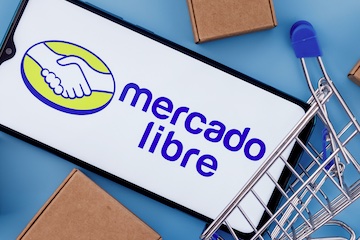Covid-19 had an unlimited impact on client buying habits in Latin America, maybe greater than in every other area. Out of necessity, individuals grew to become devoted ecommerce buyers for the primary time, shopping for necessities similar to groceries, family items, and attire.
These habits have continued, making Latin America one of the vital quickly rising ecommerce markets.
Argentina, Brazil, Chile, Colombia, Costa Rica, Mexico, Panama, and Peru comprise the highest on-line markets. Collectively in these eight international locations, 79% of the inhabitants have web entry, and 50% of them shopped on-line in 2021, in line with analysis agency RetailX, up from 33% in 2017.
Whereas Costa Rica, Panama, and Peru have restricted ecommerce income due to small populations, Brazil, Mexico, Argentina, Chile, and Colombia are exhibiting spectacular ecommerce positive aspects.
Impediments to Progress
Hurdles stay in Latin America — primarily funds and logistics. Half of the inhabitants has no checking account. Rural areas have few roads. Therefore marketplaces offering options for customers and companies dominate the area’s ecommerce.
Argentina’s Mercado Libre is the preeminent participant. Based on Bloomberg Intelligence, Mercado Libre’s income grew 90% in 2020 because the pandemic compelled the closure of brick-and-mortar shops. Mercado Libre affords its personal logistics service that gives delivery choices and warehouse stocking for native and abroad retailers. Like Amazon, Mercado Libre has its personal air cargo fleet and supply vans working in bigger markets, primarily cities.
Moreover, final yr Mercado Libre acquired Kangu, a Brazil-based logistics firm that additionally operates in Colombia and Mexico. And Pago, Mercado Libre’s fintech arm, serves as a cost processor. Customers in Brazil and Mexico may use PayPal for his or her Mercado Libre purchases.
Client Traits
Customers in Latin America stay suspicious of the standard of on-line items and depend on buyer opinions. Groceries dominated on-line gross sales throughout the pandemic. However in 2022, electronics generates essentially the most gross sales within the high eight international locations, in line with Statista, adopted by trend.
Cellular utilization varies by nation, in line with Statista. Brazil has the strongest choice for cellular for on-line buying at 48% in 2022, up from 27% in 2017. Colombians and Costa Ricans are also devotees of cellular commerce, however utilization has not elevated as a lot over the previous few years.
Nation Figures
The next information is from RetailX until in any other case famous.
Argentina. Ninety % of Argentina’s inhabitants makes use of the web. Of those, 58% store on-line. Ecommerce income in Argentina grew by 68% in 2021 in comparison with 2020, in line with the Argentine Chamber of Digital Commerce. Most internet buyers are between 25 and 44 years of age. Whereas common spend per shopper has elevated to about $420 so far in 2022 from 2021 in line with Statista, whole ecommerce income has decreased on account of a struggling Argentine economic system.
Brazil. In 2021 on-line gross sales have been greater than double what they have been in 2019 and 30% increased than in 2020. Eighty-four % of the inhabitants makes use of the web, with 53% of web customers buying on-line — up from 38% in 2017.
Brazilian ecommerce buyers are usually youthful; roughly half are lower than 35 years outdated. Solely 9% are 55 or above. The typical annual on-line spending quantity is $397.
Chile. Chile has the very best proportion of web customers and ecommerce adoption. Ninety-four % of the inhabitants makes use of the web, and 62% of these customers store on-line. Chile has a better gross home product than most Latin American international locations, and the common annual spend of ecommerce buyers is excessive at $780 so far for 2022.
Colombia. In 2021, Colombia was Latin America’s third-largest ecommerce market. Forty-nine % of web customers store on-line, a rise from 28% in 2017. Fifty-three % of these buyers are 34 or beneath. Transportation networks in Colombia are poor and insufficient for quick supply, however customers appear undeterred.
Costa Rica. Costa Rica’s inhabitants is simply 5.2 million. Eighty % are web customers, however solely 45% store on-line. Nonetheless, the choice for on-line buying has been doubling since 2017. The typical annual ecommerce spend will doubtless attain $711 in 2022 — up from $477 in 2019.
Mexico. Ecommerce income in Mexico grew by 81% from 2019 to 2020, in line with the Mexican On-line Gross sales Affiliation, making it the fourth fastest-growing ecommerce market on this planet.
Mexico will doubtless have round 77 million ecommerce buyers by 2025 as improved infrastructure and digital literacy drive adoption. That’s up from 50.7 million ecommerce buyers in 2020.
Mexico has skilled essentially the most substantial shift to on-line of all Latin American markets, particularly for groceries, which have grown over 100% because the pandemic started. Seventy-six % of the inhabitants have been web customers in 2021, with 44% buying on-line, a rise from 26% in 2017. On-line consumers will doubtless spend a median of $727 in 2022 versus 2017’s $249.
Panama. Of Panama’s 4.3 million residents, virtually three-quarters are web customers. Forty-six % of these customers store on-line, up from 25% in 2017, buying a median of $710 in 2022.
Peru. In 2021, 71% of Peruvians have been web customers. Forty-four % of the customers shopped on-line in 2021, in comparison with 25% in 2017. A 3rd of ecommerce buyers in Peru are 25 to 34 years of age, whereas 20% are 45 or over.

